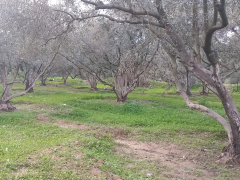Last week, a ceasefire was announced after two years of genocide in Gaza. The bombs have stopped falling, but the devastation remains. The majority of homes, schools, hospitals, universities, factories, and commercial buildings have been reduced to rubble. From above, Gaza looks like a grey desert of rubble, its vibrant urban spaces reduced to ghost towns, its lush agricultural land and greenery wiped out.
The occupier’s aim was not only to render the Palestinians of Gaza homeless but also unable to provide for themselves. Uprooting the dispossessed and impoverished, those who have lost their connection to the land, is of course much easier.
This was the goal when Israeli tanks and bulldozers entered my family’s plot of land in the eastern part of Maghazi refugee camp and uprooted 55 olive trees, 10 palms and five fig trees.
This plot of land was offered to my refugee grandfather, Ali Alsaloul, by its original owner as a place to shelter in during the Nakba of 1948. Ali, his wife, Ghalia, and their children had just fled their village, al-Maghar, as Zionist forces advanced on it. Al-Maghar, like Gaza today, was reduced to rubble; the Zionists who perpetrated the crime completed the erasure by establishing a national park on its ruins – “Mrar Hills National Park”.
Ali was a farmer and so were his ancestors; his livelihood had always come from the land. So when he settled in the new location, he was quick to plant it with olive trees, palms, figs and prickly pears. He built his house there and raised my father, uncles and aunts. My grandfather eventually bought the land from its generous owner, by paying in installments over many years. Thus, my family came into the possession of 2,000 square metres (half an acre) of land.
Although my father and his siblings married and moved out of their family home, this plot of land remained a favourite place to go, especially for me.
It was just two kilometres away from our house in Maghazi refugee camp. I enjoyed doing the 30-minute walk, part of which went through a complete “jungle”: a stretch of green populated with clover, sycamore, jujube and olive trees, colourful birds, foxes, leashed and unleashed dogs and many beehives.
Every autumn, in October, when the olive picking season began, my cousins, friends and I would gather to collect the olives. It was an occasion that brought us closer together. We would get the olives pressed and get 500 litres (130 gallons) of olive oil from the harvest. The figs and dates were made into jams to have for breakfast or for suhoor during Ramadan.
The rest of the year, I would often mee





